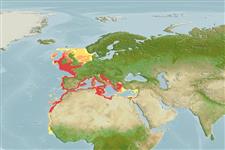>
Eupercaria/misc (Various families in series Eupercaria) >
Cepolidae (Bandfishes) > Cepolinae
Etymology: Cepola: Latin, cepulla = onion.
More on author: Linnaeus.
Environment: milieu / climate zone / depth range / distribution range
Écologie
marin démersal; profondeur 15 - 400 m. Subtropical; 61°N - 10°N, 18°W - 36°E
Eastern Atlantic: British Isles to north of Senegal, including the Mediterranean.
Length at first maturity / Taille / Poids / Âge
Maturity: Lm 24.2 range ? - ? cm
Max length : 80.0 cm TL mâle / non sexé; (Ref. 27156); common length : 40.0 cm TL mâle / non sexé; (Ref. 26999)
Épines dorsales (Total): 0; Rayons mous dorsaux (Total): 67-70; Rayons mous anaux: 60. Body ribbon-like, gradually tapering to a pointed tail. Large, oblique mouth. Teeth widely spaced on both jaws. First two rays of dorsal fin unsegmented. Caudal fin with median rays longer and free at their tip. Dorsal and anal fins more or less joined to the caudal fin.
Found on sand and mud bottom (Ref. 26999). Lives in vertical burrows but may be found swimming in midwater. Occurs singly or in groups. Feeds mainly on small crustaceans and chaetognaths (Ref. 5984).
Eggs are pelagic.
Quéro, J.-C., 1990. Cepolidae. p. 853-854. In J.C. Quero, J.C. Hureau, C. Karrer, A. Post and L. Saldanha (eds.) Check-list of the fishes of the eastern tropical Atlantic (CLOFETA). JNICT, Lisbon; SEI, Paris; and UNESCO, Paris. Vol. 2. (Ref. 5985)
Statut dans la liste rouge de l'IUCN (Ref. 130435)
Menace pour l'homme
Harmless
Utilisations par l'homme
Pêcheries: intérêt commercial mineur
Plus d'informations
RéférencesAquacultureProfil d'aquacultureSouchesGénétiqueElectrophoresesHéritabilitéPathologiesTraitementNutrientsMass conversion
Outils
Articles particuliers
Télécharger en XML
Sources Internet
Estimates based on models
Preferred temperature (Ref.
123201): 9.8 - 16.5, mean 11.9 °C (based on 326 cells).
Phylogenetic diversity index (Ref.
82804): PD
50 = 0.5312 [Uniqueness, from 0.5 = low to 2.0 = high].
Bayesian length-weight: a=0.00380 (0.00284 - 0.00508), b=2.42 (2.34 - 2.50), in cm total length, based on LWR estimates for this species (Ref.
93245).
Niveau trophique (Ref.
69278): 3.1 ±0.23 se; based on food items.
Résilience (Ref.
120179): Milieu, temps minimum de doublement de population : 1,4 à 4,4 années (K=0.21; tmax=8).
Fishing Vulnerability (Ref.
59153): Moderate to high vulnerability (55 of 100).
Climate Vulnerability (Ref.
125649): Moderate vulnerability (38 of 100).
Nutrients (Ref.
124155): Calcium = 57.7 [33.8, 110.7] mg/100g; Iron = 0.981 [0.583, 1.722] mg/100g; Protein = 18.2 [17.3, 19.1] %; Omega3 = 0.218 [0.131, 0.362] g/100g; Selenium = 47.5 [24.0, 95.1] μg/100g; VitaminA = 12.1 [3.9, 40.0] μg/100g; Zinc = 0.669 [0.462, 0.963] mg/100g (wet weight);
